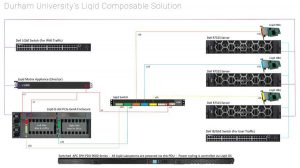Durham University/ICC Deploys Liqid Composable Disaggregated Infrastructure Software For COSmology MAchine
Part of system used to study origins of universe
This is a Press Release edited by StorageNewsletter.com on June 27, 2022 at 2:00 pmLiqid Inc. announced a case study with Durham University in Durham, England, describing its deployment of the company’s Composable Disaggregated Infrastructure (CDI) software.
Durham University is home to the COSmology MAchine (COSMA) operated by the Institute for Computational Cosmology (ICC) and is a national supercomputing facility that is part of the UK’s Distributed Research utilizing Advanced Computing (DiRAC) system. The company’s Matrix CDI software is part of a system used to study the origins of the universe, composing disaggregated GPUs in a tight footprint designed for a more sustainable digital architecture. With the ability to grow as resources are needed, the Liqid system will help researchers in the UK and around the world unlock the mysteries of the 14 billion-year history of the cosmos with greater speed and efficiency than traditional data center systems.
“We are honored to work with institutions like Durham University and COSMA researchers to provide the resources to better explore the most profound questions in science,” said Sumit Puri, CEO and cofounder, Liqid. “By providing the kind of software-defined data performance and architectural flexibility for powerful GPU, Liqid is enabling research breakthroughs that would have been impossible with traditional, static data center architectures so scientists can focus on results instead of waiting for resources and performance to become available.”
Liqid Matrix CDI delivers Big Bang for cosmologists with adaptive architecture
Click to enlarge
“Durham University is using cutting-edge CDI to accelerate research, improve resource utilization, and reduce the university’s carbon footprint,” said Alistair Basden, technical manager, DiRAC Memory Intensive Service, Durham University, who was interviewed for the case study entitled Durham University’s Institute for Computational Cosmology Accelerates Results with Composability from Liqid.
The COSMA memory-intensive system is designed to support the largest cosmological simulations, most notably running simulations starting with the Big Bang and propagating through the entire history of the universe. Each simulation of dark matter, dark energy, black holes, galaxies and other structures in the universe often takes months to run, followed by long periods of data analysis.
While all of the applications deployed by DiRAC are memory intensive, valuable GPU resources are required for some of its most challenging simulations and analysis. The university chose the firm’s Matrix software-based composable system in order to be able to share and scale GPUs in the exact amounts required for any given workload. Once the workload has been completed, GPU resources can be redistributed through Matrix software for use by other applications.
“It would be wasteful for us to populate all our nodes with GPUs,” Basden said in an interview for the case study. “Instead, we have some fat compute nodes and a login node, and we’re able to move GPUs between those systems. Composing our GPUs gives us flexibility with a smaller number of GPUs. We can individually populate the servers with one or more GPUs as required at the click of a button.”
Durham University IT is also deploying Matrix-based systems as an element of its overall strategy for a more sustainable IT ecosystem. Software-based composability enables users to do more with less, increasing efficiency and curtailing the need for physical space to store the hardware while providing significant reductions in cooling and water requirements.
“Rather than populating all our servers with GPUs, we can compose the resources we need to each server. That reduces our carbon footprint,” said Basden.
Resources:
Durham University’s Institute for Computational Cosmology Accelerates Results with Composability from Liqid case study (PDF)
About Liqid’s academic deployments, review Liqid’s case study outlining the company’s work with the University of Illinois at Chicago’s Electronic Visualization Laboratory
















 Subscribe to our free daily newsletter
Subscribe to our free daily newsletter

